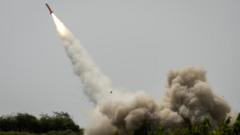In the wake of Russia's ongoing military actions in Ukraine, a significant shift is unfolding in Eastern Europe. Five nations—Poland, the Baltic States, and Finland—are reconsidering their stance on the deployment of antipersonnel mines, a weapon that has been largely banned for over 25 years. This potential revival of landmines has alarmed the humanitarian community and reignited debates about safety and security measures along Europe’s borders.
Land Mines Resurgence: Eastern Europe Faces Threats and Choices

Land Mines Resurgence: Eastern Europe Faces Threats and Choices
Five nations contemplate reviving the use of antipersonnel mines as tensions escalate, threatening decades of progress in humanitarian efforts.
Historically, the borders between the Soviet Union and the West were heavily fortified with these deadly devices, deterring populations from escaping oppressive conditions. Following the Cold War, extensive efforts were dedicated to removing these mines, prompted in part by a global treaty that sought to eliminate their use altogether following advocacy from figures such as Princess Diana.
However, the recent actions by Eastern European countries, including a declaration by Ukraine's President Volodymyr Zelensky to reconsider their commitments under the Mine Ban Treaty, signal a stark turnaround as these nations brace for future threats. While this decision does not immediately translate to increased mine deployment—given that exiting the treaty is a lengthy, six-month process—the intent has drawn sharp criticism. Advocacy groups like the International Campaign to Ban Landmines have expressed outrage, emphasizing the dangers such a decision poses to civilians who bear the brunt of landmine-related casualties.
This re-evaluation of landmines amid intensifying geopolitical tensions reflects a desperate response to perceived threats, raising critical questions about humanitarian laws and the long-term implications for civilian safety in conflict zones.
As Europe confronts a renewed era of military threats, the debate over the use of antipersonnel mines becomes more pressing—pitting national security concerns against the longstanding gains made for humanitarian protections.
However, the recent actions by Eastern European countries, including a declaration by Ukraine's President Volodymyr Zelensky to reconsider their commitments under the Mine Ban Treaty, signal a stark turnaround as these nations brace for future threats. While this decision does not immediately translate to increased mine deployment—given that exiting the treaty is a lengthy, six-month process—the intent has drawn sharp criticism. Advocacy groups like the International Campaign to Ban Landmines have expressed outrage, emphasizing the dangers such a decision poses to civilians who bear the brunt of landmine-related casualties.
This re-evaluation of landmines amid intensifying geopolitical tensions reflects a desperate response to perceived threats, raising critical questions about humanitarian laws and the long-term implications for civilian safety in conflict zones.
As Europe confronts a renewed era of military threats, the debate over the use of antipersonnel mines becomes more pressing—pitting national security concerns against the longstanding gains made for humanitarian protections.




















